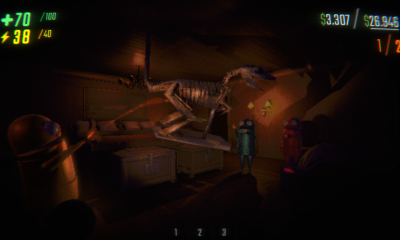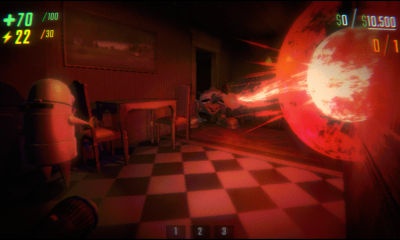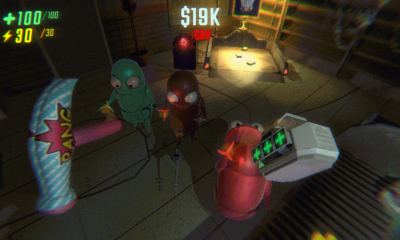Immersive Echoes: A Journey Through the Dynamic Universe of R.E.P.O.
My First Encounter with R.E.P.O.
I remember the day I first launched R.E.P.O. clearly—it was like stepping through a portal into a realm uniquely crafted for immersive entertainment. From the loading screen that gently invited me into the world to the initial tutorial that expertly guided me without feeling intrusive, every element felt as though it had been meticulously woven together. I was immediately captivated by the promise of exploring both familiar and innovative forms of gameplay that defied conventional norms.
Navigating a Dynamic Virtual Universe
As I embarked on my journey through R.E.P.O., the game revealed an expansive, intricate universe with meticulously designed maps and a myriad of interactive spaces. Every region within the game had its own distinct charm and challenges. Whether maneuvering through labyrinthine alleys in futuristic cityscapes or exploring enigmatic, nature-infused environments that evoked both wonder and tension, I was pleasantly surprised by the logical consistency and imaginative scope of the world. The game’s navigation system, refined over layers of design evolution, provided constant excitement with its hidden secrets and subtle nods to deeper lore waiting to be discovered.
Exploring the Depths of the Narrative
The storyline of R.E.P.O. is an intricate tapestry of personal quests, global conundrums, and unexpected twists that built upon each other to create a narrative both compelling and thought-provoking. I found myself drawn to the character arcs, each imbued with emotional weight and subtle complexities that added depth to every decision made throughout the game. The dialogue, delivered in both quiet moments of solitude and high-energy exchange with other characters, resonated on a personal level. I appreciated how the storytelling unfolded organically, permitting a blend of guided events and the freedom of exploration that kept the narrative from feeling overly scripted.
Mastering the Art of Real-Time Strategy
One of the aspects that truly enthralled me about the game was its real-time strategy component. R.E.P.O. combines traditional role-playing dynamics with exigent strategic challenges that require both quick thinking and careful planning. I recall several moments where a seemingly spontaneous decision had far-reaching impacts on the unfolding events in the game. The careful balance between resource management, territory control, and character development made each action meaningful, ensuring that my choices shaped the game's universe in a way that felt organic and rewarding. The system was as smooth as it was challenging, constantly inviting me to refine my tactics and adopt new approaches in the heat of complex encounters.
Innovative Mechanics and Interactivity
What sets R.E.P.O. apart is its innovative blend of mechanics that straddle both conventional gameplay ideas and bold new experimental concepts. The game integrates puzzle elements with dynamic combat in a framework where logic, creativity, and precision are valued equally. On several occasions, I found myself analyzing the interplay between different mechanics after a particularly nail-biting sequence, marveling at how well they meshed together. The multi-layered objectives, ranging from simple task completions to elaborate challenges that required meticulous planning, pushed me to think beyond standard solvers and encouraged me to experiment with new strategies and combinations that consistently kept the gameplay fresh and engaging.
The Soundscape and Audio Ambience
The audio design in R.E.P.O. deserves special recognition. Every sound—from the subtle hum of distant machinery to the vibrant score that accompanied high-tension moments—contributed to an immersive experience that was as intense as it was atmospheric. I spent many hours simply absorbing the layered effects that the developers so thoughtfully placed. The adaptive soundtrack was particularly impressive, seamlessly adjusting to the intensity of the moments, whether it was during a quiet exploration of a deserted outpost or a dramatic sequence of events that questioned my in-game decisions. The game’s soundscape was not merely an accompaniment to the action; it was a narrative device in its own right.
The Visual Artistry of R.E.P.O.
Every frame of R.E.P.O. is an aesthetic exploration in itself, blending artistic finesse with technological prowess. The visual design ranges from ultra-detailed character models and expression animations to expansive landscapes that managed to balance gritty realism with imaginative elements. I found the use of contrasting color palettes both exciting and refreshing—the sharper hues during intense gameplay sequences provided a stark contrast to the more thoughtful, subdued tones used as backdrops for narrative revelations. The dynamic lighting effects during moments of tension and relief elevated the overall atmosphere and made even the smallest details feel significant. It feels like each visual element is a deliberate brushstroke on a vibrant canvas, inviting players to appreciate the confluence of art and interactive storytelling.
Interactive Character Development and Engagement
The game’s character development system is another feature that deeply resonated with me. Unlike many titles where character progressions can feel arbitrary, R.E.P.O. offered a coherent evolution that was closely aligned with the narrative. As I advanced through quests and challenges, I could see my choices reflected in my character’s skill set and personality traits. The ability to tailor my character’s attributes based on my preferred play style made each encounter uniquely personal. The relationships built within the game were also intricately handled—trust and rivalry were explored through a blend of dialogue options and real-time decisions, making every interaction feel layered and consequential.
Technological Fluidity and System Performance
From a technical standpoint, I was impressed by how seamlessly R.E.P.O. merged complex gameplay systems with fluid performance. The responsiveness of user inputs, the minimal load times, and the robust anti-lag design were things I often took for granted in the digital world. However, in the context of R.E.P.O., they collectively enhanced the sense of immersion. My game felt snappy and responsive at every turn, with a UI that was both intuitive and aesthetically pleasing, ensuring that I never lost track of the meticulous details. It was evident that the developers had paid special attention to system optimization, which allowed the rich visual and narrative elements to flourish without encountering performance hitches.
Exploration and World-Building Through Side Quests
Beyond the main narrative, R.E.P.O. excels in providing a universe filled with intriguing side quests and hidden story elements. Every quest felt like a mini-episode on its own, complete with its own set of challenges and insights into the broader game world. I often took breaks from the primary storyline to delve into these smaller adventures, each of which enriched my understanding of the universe's history and the struggles of its inhabitants. The choices available in these quests were notably diverse, and each decision held tangible weight, altering not just the immediate quest resolution but sometimes even the future events of the game. It was an exploration of intricacies that made every session feel loaded with new, personalized discoveries.
Adaptive Difficulty and Engagement Curves
One of the most commendable features of R.E.P.O. is its adaptive difficulty system, which tailors challenges to fit the progress and expertise of its players. I found that the game was clever in detecting areas where I might be struggling and adjusted the intensity of encounters in subtle ways, ensuring that my experience remained challenging without becoming frustrating. This thoughtful calibration not only tested my skills but also allowed me to learn and adapt gradually. I appreciated the dynamic balance between risk and reward that the system introduced—each hurdle was deliberately placed to encourage creative thinking and strategic flexibility rather than merely overwhelming me with rapid-fire challenges.
Immersive Environmental Interactions and Realism
Venturing into the various environments within R.E.P.O. was always an adventure in itself. I was particularly struck by the level of detail in the interactive environments. Every corner of the game world felt alive and reactive—weather patterns would shift, natural disturbances unfolded in unexpected ways, and the physics engine created satisfying, tactile interactions with objects. Whether it was unlocking a secret passage through the manipulation of environmental elements or engaging in tactical maneuvers based on the terrain, every step felt like it was deeply interconnected with the game’s ecosystem. I found that these elements of environmental interactivity not only enhanced immersion but also cultivated an intimate connection between me and the expansive universe.
Community Integration and Live Interactions
Although R.E.P.O. is primarily an immersive single-player experience, it doesn’t neglect the benefits of community interaction. Periodic live events within the game pulled me into a broader conversation with other enthusiasts—this was more than just an update but a shared experience that resonated with many players worldwide. The forums and in-game leaderboards added layers of friendly competition and storytelling, fostering a sense of belonging and engagement that extended beyond the device’s screen. It was invigorating to see fellow players contribute their insights and creative approaches to problems, making R.E.P.O. not just a game, but a continuously evolving community project that bridged narrative with shared ingenuity.
Subtle Details that Build a Larger World
A feature that truly stood out throughout my time with R.E.P.O. was the attention given to small, often understated details that cumulatively built an immersive world. I observed seemingly insignificant elements—a weathered insignia on a crumbling wall, cryptic notes tucked away in forgotten corners, and snippets of lore dropped into casual conversation with non-playable characters—that enriched the overall narrative. Such details invited me to pause and consider the broader history and cultural tapestry woven into the game. The sheer scale of these meticulous touches not only demonstrated an artistic depth that is rare in modern titles but also built a repository of myths and legends that beckoned exploration long after each session concluded.
Pros
- Immersive narrative that captivates players from the start.
- Expansive and detailed universe filled with diverse environments.
- Adaptive difficulty that scales with player progress.
- Innovative mechanics that blend various gameplay elements seamlessly.
- Fluid system performance with responsive controls and minimal load times.
- Engaging character development that reflects player choices.
Cons
- Complexity may overwhelm new players unfamiliar with intricate systems.
- Occasional steep learning curve could deter those preferring straightforward gameplay.
- Some performance hitches in resource-heavy scenes may disrupt the immersive experience.

R.E.P.O.
Great
New on Blog
-
- Kayla Cruz
- 19 May 2025

-
- Kayla Cruz
- 19 May 2025

-
- Ryan Gutierrez
- 05 May 2025

-
- Kayla Cruz
- 05 May 2025






